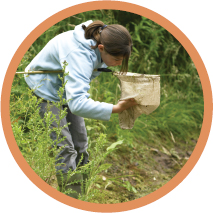
Полная версия
Rivers, Ponds and Lakes

3 But if you are keeping your creatures for any longer, some gentle filtration and water circulation is a good idea. This keeps the water from becoming stagnant, ups the oxygen levels and removes and prevents a build-up of harmful substances. All this can be provided by an in-tank filter pump, again relatively cheap and available in many sizes, depending on the size of the tank it needs to filter. For species that live in running water, you may need to have quite an aggressive water flow, but the principles are the same.

4 Use rain water or water from where you got your creatures. Tap water can be used, but as there is added chlorine, it needs to stand for a few days before putting in your catch. Ideally, set up your aquarium a week in advance of adding them.
Make a micro zoo

The thing about ponds and lakes is that they are busy with life. Because they are so chock-a-block, competition for resources, like space and food, is intense. Puddles, on the other hand, tend to dry up from time to time and so are relatively empty. Now, to any creature this represents a challenge: to get life in a puddle licked you must have a speedy life cycle. You must be able to adapt so you can handle the extreme and often rapid changes in temperatures as well as sometimes very salty conditions. Do this, and you have the place pretty much to yourself.
Yes, puddle life is tough. But there are some creatures that have become puddle specialists. A couple of groups, such as the tadpole shrimps (or triops) and the brine shrimps, are rare in the wild in Europe, but they can be bred in captivity relatively easily. This means that you do not have to go out looking for them, but can actually buy them as eggs (see page 71) and rear them as a micro zoo or go pond dipping and see what you can catch (see opposite).
In the wild, these animals whizz through their life as soon as rain water fills the dents and the depressions that become puddles. They grow and filter out any nutrients from the mud and water (algae and various microscopic creatures are also quick to colonize these puddles). In fact, they can turn their lives around, from egg to adult to egg, in less than two weeks!
When eventually the puddle disappears, every creature dries up and becomes dust too. It sounds harsh, but this is dust with a difference – it’s living dust. In the dried-up mud they will have laid eggs and these minuscule capsules of life are able to withstand incredibly hot, dry conditions and so sit it out, waiting for the next downpour – and around they go again!

A hugely magnified triops, which springs back to life once you have nourished it with water and food.
YOU WILL NEED
> fine net
> plastic container with lid
> small pipette or plastic syringe
> collection of small jars or test tubes
> magnifying lens

1 Take your fine net out to a pond near you. Try to choose one with good clear water and go hunting on a bright day. All the creatures should be near the surface, making the most of the warmer water. Put your catch in a plastic container with a lid and take it home.

2 Once you’ve got home, use a pipette or spoon to sort out the truly tiny creatures from the slightly larger ones. It is the smallest ones that you want to keep for your micro zoo. There wouldn’t be much point in calling it a micro zoo otherwise.

3 Keep your super-small finds in a test tube or a similar lidded container and feed them regularly with green water (see page 21).

Take it further
Sometimes you will come across something in your catch that doesn’t belong to your micro zoo, but is nevertheless worthy of investigation with a magnifying lens. Here we found a snail egg case on a stick – all the little dots are the newly hatched snails that are crawling around (see also page 35).
Feed your micro zoo
The problem with having traditional pets is that there is not a lot of mystery surrounding their lives. You can buy books on how to keep them, so the challenge simply isn’t there. This is where my idea of the perfect pets comes in – the micro zoo that we created on the previous page. They are small, easy to keep and they won’t leave unwanted hairs on the sofa. In fact, as they are so small, you can build up a collection of them.
Конец ознакомительного фрагмента.
Текст предоставлен ООО «ЛитРес».
Прочитайте эту книгу целиком, купив полную легальную версию на ЛитРес.
Безопасно оплатить книгу можно банковской картой Visa, MasterCard, Maestro, со счета мобильного телефона, с платежного терминала, в салоне МТС или Связной, через PayPal, WebMoney, Яндекс.Деньги, QIWI Кошелек, бонусными картами или другим удобным Вам способом.





